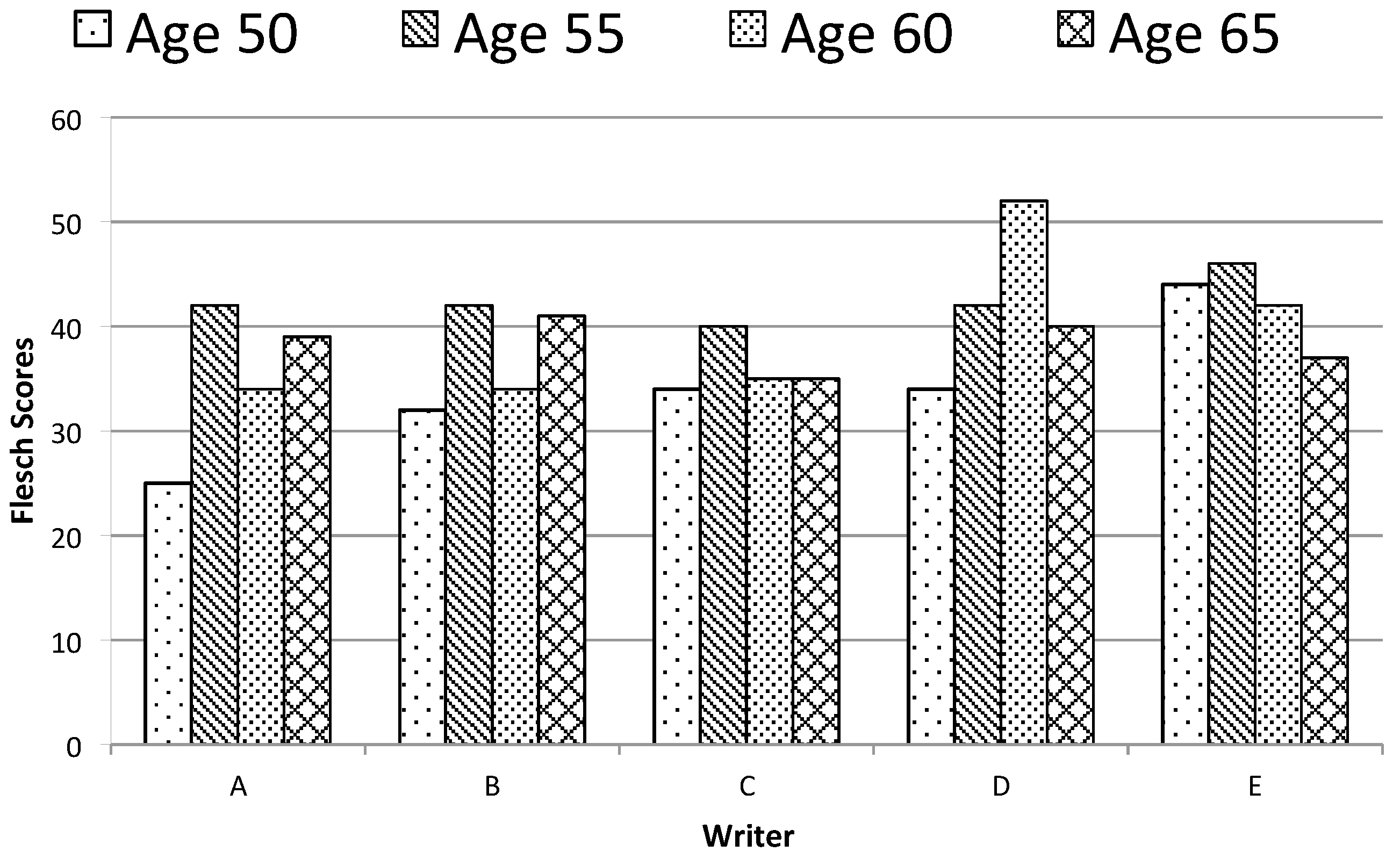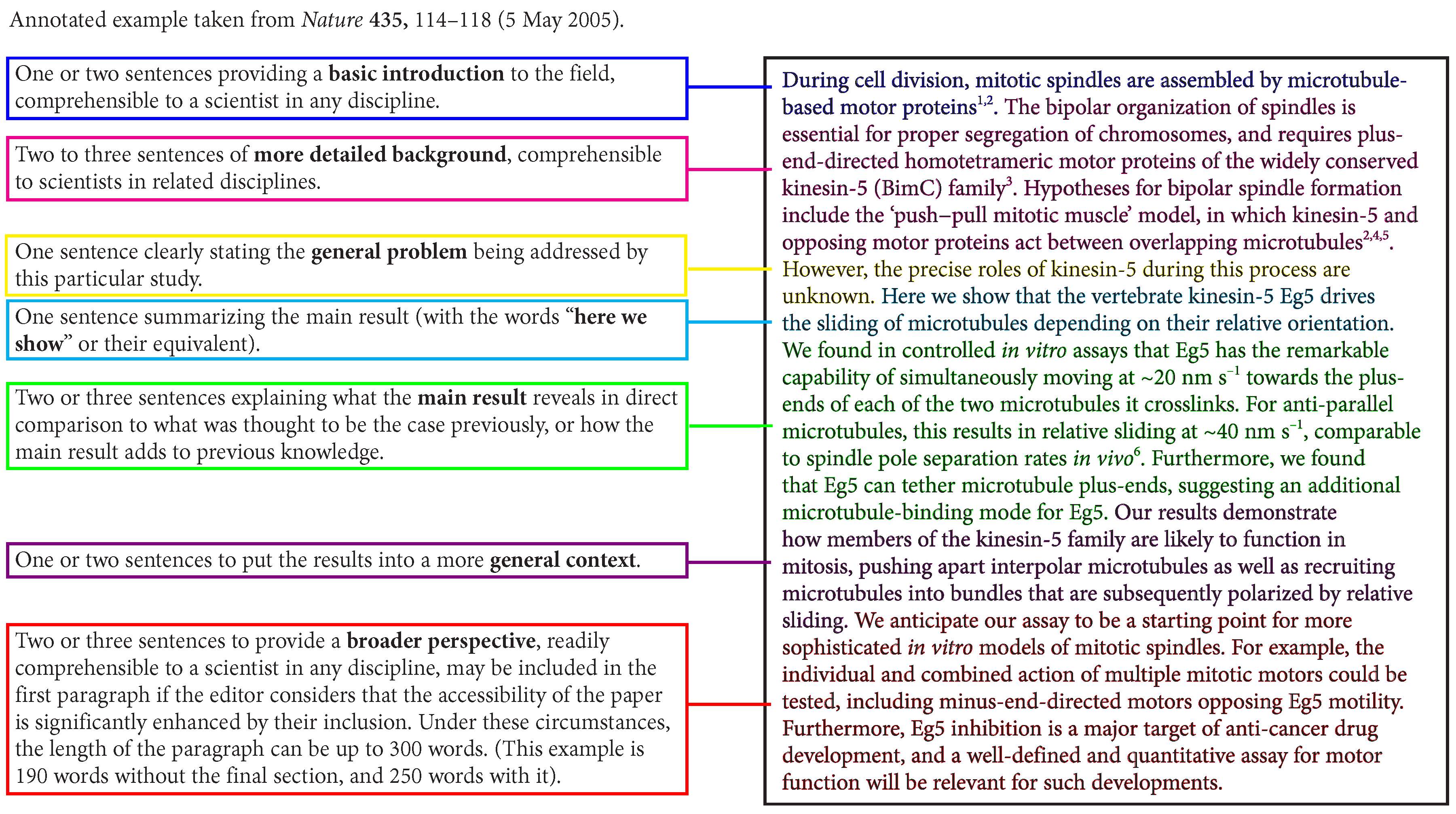Thirteen Ways to Write an Abstract
Abstract
:1. Introduction
Version 1: The Block Format
- Abstract. This paper focuses on the issue of whether or not academic writing changes over time. We examine a selection of book reviews written by five authors over a 20–25 years period. The data show little evidence of change for each of these authors as measured by readability scores and grammatical features. These findings are in line with earlier ones that suggest that academic writing styles are fixed fairly early on and do not alter much with time.
Version 2: Spaced Text
- This paper focuses on the issue of whether or not academic writing changes over time.
- We examine a selection of book reviews written by five authors over a 20–25 years period.
- The data show little evidence of change for each of these authors as measured by readability scores and grammatical features.
- These findings are in line with earlier ones that suggest that academic writing styles are fixed fairly early on and do not alter much with time.
Version 3: Structured Abstracts
- Background. There has been little research examining how academic writing changes with time.
- Aim. The aim of this study was to see whether or not an author’s style when writing an academic book review changes over time.
- Method. We examined a selection of book reviews written by five authors over a 20–25 years period. For each author we recorded the number of words, the number of paragraphs, the average sentence lengths, the use of passive tenses, and reading difficulty, as measured by the Flesch Reading Ease scale and the grade scores.
- Results. The data showed that whilst the individual authors varied in their styles, each was consistent across the 20–25 years period.
- Conclusions. Academic writing styles are fixed fairly early on and do not alter much with time.
Version 4: Adding in Key Words
- Background. There has been little research examining how academic writing changes with time.
- Aim. The aim of this study was to see whether or not an author’s style when writing an academic book review changes over time.
- Method. We examined a selection of book reviews written by five authors over a 20–25 years period. For each author we recorded the number of words, the number of paragraphs, the average sentence lengths, the use of passive tenses, and reading difficulty, as measured by the Flesch Reading Ease scale and the grade scores.
- Results. The data showed that whilst the individual authors varied in their styles, each was consistent across the 20–25 years period.
- Conclusions. Academic writing styles are fixed fairly early on and do not alter much with time.
- Key words. book reviews; readability; age
Version 5: Abstracts Containing Electronic Links to Previous Research
- Background. There has been little research examining how academic writing changes with time.
- Aim. The aim of this study was to see whether or not an author’s style when writing an academic book review changes over time (Hartley & Cabanac, 2015; Hartley, Howe and McKeachie, 2001).
- Method. We examined a selection of book reviews written by five authors over a 20–25 year period. For each author we recorded the number of words, the number of paragraphs, the average sentence lengths, the use of passive tenses, and reading difficulty, as measured by the Flesch Reading Ease scale and the grade scores (Hartley & Cabanac, 2016).
- Results. The data showed that whilst the individual authors varied in their styles, each was consistent across the 20–25 years period.
- Conclusions. Academic writing styles are fixed fairly early on and do not alter much with time.
- Key words. book reviews; readability; age
Version 6: Abstracts with Highlights
- Academic writing styles change little with age when writing book reviews
- …
Version 7. Readable Abstracts
- What is already known about this topic?There are few studies of academic writing over time, but most assume that writing improves with practice.
- What are the implications of this study for practice and/or policy?None.
Version 8: Tweetable Abstracts
- Academic writing styles change little with age when writing book reviews—study finds.
Version 9: One-Sentence Abstracts
- TL;DR: Academic writing styles change little with age when writing book reviews.
Version 10: One-Word Abstracts
Version 11: Graphical Abstracts
Version 12: Video Abstracts
Version 13: Computer-Generated Abstracts
2. Concluding Remarks
- “We strongly encourage authors to use the … style of structured abstracts, but without the headings.”
Acknowledgments
Author Contributions
Conflicts of Interest
References
- Hartley, J. Academic Writing and Publishing: A Practical Handbook; Routledge: Abingdon, UK, 2008. [Google Scholar]
- Hartley, J.; Cowan, J.; Deeson, C.; Thomas, P. Book reviews in time. Scientometrics 2016, 109, 2123–2128. [Google Scholar] [CrossRef]
- Hartley, J. More sex please, we’re psychologists. Psychologist 2004, 17, 80–81. [Google Scholar]
- Hartley, J.; Betts, L. Common weaknesses in traditional abstracts in the social sciences. J. Am. Soc. Inf. Sci. Technol. 2009, 60, 2010–2018. [Google Scholar] [CrossRef]
- Hartley, J. Current findings from research on structured abstracts: An update. J. Med. Libr. Assoc. 2014, 102, 146–148. [Google Scholar] [CrossRef] [PubMed]
- Hartley, J. What’s new in abstracts of science articles? J. Med. Libr. Assoc. 2016, 104, 235–236. [Google Scholar] [CrossRef] [PubMed]
- Kuehne, L.M.; Olden, J.D. Lay summaries needed to enhance science communication. Proc. Natl. Acad. Sci. USA 2015, 112, 3585–3586. [Google Scholar] [CrossRef] [PubMed]
- Else, H. Tell us about your paper—And make it short and tweet. Times Higher Education, 9 July 2015. [Google Scholar]
- Tonia, T.; Van Oyen, H.; Berger, A.; Schindler, C.; Künzli, N. If I tweet will you cite? The effect of social media exposure of articles on downloads and citations. Int. J. Public Health 2016, 61, 513–520. [Google Scholar] [CrossRef] [PubMed]
- Berry, M.V.; Brunner, N.; Popescu, S.; Shukla, P. Can apparent superluminal neutrino speeds be explained as a quantum weak measurement? J. Phys. A Math. Theor. 2011, 44, 492001. [Google Scholar] [CrossRef]
- Gardner, J.K.; Knopoff, L. Is the sequence of earthquakes in Southern California, with aftershocks removed, Poissonian? Bull. Seismol. Soc. Am. 1974, 64, 1363–1367. [Google Scholar]
- Gutmann, P. Do Users Verify SSH keys? Login 2011, 36, 35–36. [Google Scholar]
- Gilaberte, Y.; Nagore, E.; Arias-Santiago, S.; Moreno, D. Is a Picture Worth a Thousand Words? The Graphical Abstract. Actas Dermo-Sifiliogr. 2016, 107, 545–546. [Google Scholar] [CrossRef] [PubMed]
- Pferschy-Wenzig, E.M.; Pferschy, U.; Wang, D.; Mocan, A.; Atanasov, A. Does a Graphical Abstract Bring More Visibility to Your Paper? Molecules 2016, 21, 1247. [Google Scholar] [CrossRef] [PubMed]
- Spicer, S. Video abstracts are a low-barrier means for publishers to extend the shelf life of research. London School of Economics—Impact of the Social Sciences Blog, 2 May 2014. [Google Scholar]
- Luhn, H.P. The automatic creation of literature abstracts. IBM J. Res. Dev. 1958, 2, 159–165. [Google Scholar] [CrossRef]
- Saggion, H.; Poibeau, T. Automatic text summarization: Past, present and future. In Multi-Source, Multilingual Information Extraction and Summarization; Poibeau, T., Saggion, H., Piskorski, J., Yangarber, R., Eds.; Springer: Berlin, Germany, 2012; pp. 3–21. [Google Scholar]
- Ufnalska, S.; Hartley, J. How can we evaluate the quality of abstracts. Eur. Sci. Ed. 2009, 35, 69–71. [Google Scholar]
- Hartley, J. Improving the clarity of journal abstracts in Psychology. Sci. Commun. 2003, 24, 366–379. [Google Scholar] [CrossRef]
| 1 | See, e.g., https://openreview.net/forum?id=rJY0-Kcll |
| 2 | |
| 3 | Elsevier’s web page “Graphical Abstracts” at https://www.elsevier.com/authors/journal-authors/graphical-abstract provides several examples taken from published articles in a variety of disciplines. |


© 2017 by the authors. Licensee MDPI, Basel, Switzerland. This article is an open access article distributed under the terms and conditions of the Creative Commons Attribution (CC BY) license (http://creativecommons.org/licenses/by/4.0/).
Share and Cite
Hartley, J.; Cabanac, G. Thirteen Ways to Write an Abstract. Publications 2017, 5, 11. https://doi.org/10.3390/publications5020011
Hartley J, Cabanac G. Thirteen Ways to Write an Abstract. Publications. 2017; 5(2):11. https://doi.org/10.3390/publications5020011
Chicago/Turabian StyleHartley, James, and Guillaume Cabanac. 2017. "Thirteen Ways to Write an Abstract" Publications 5, no. 2: 11. https://doi.org/10.3390/publications5020011
APA StyleHartley, J., & Cabanac, G. (2017). Thirteen Ways to Write an Abstract. Publications, 5(2), 11. https://doi.org/10.3390/publications5020011





